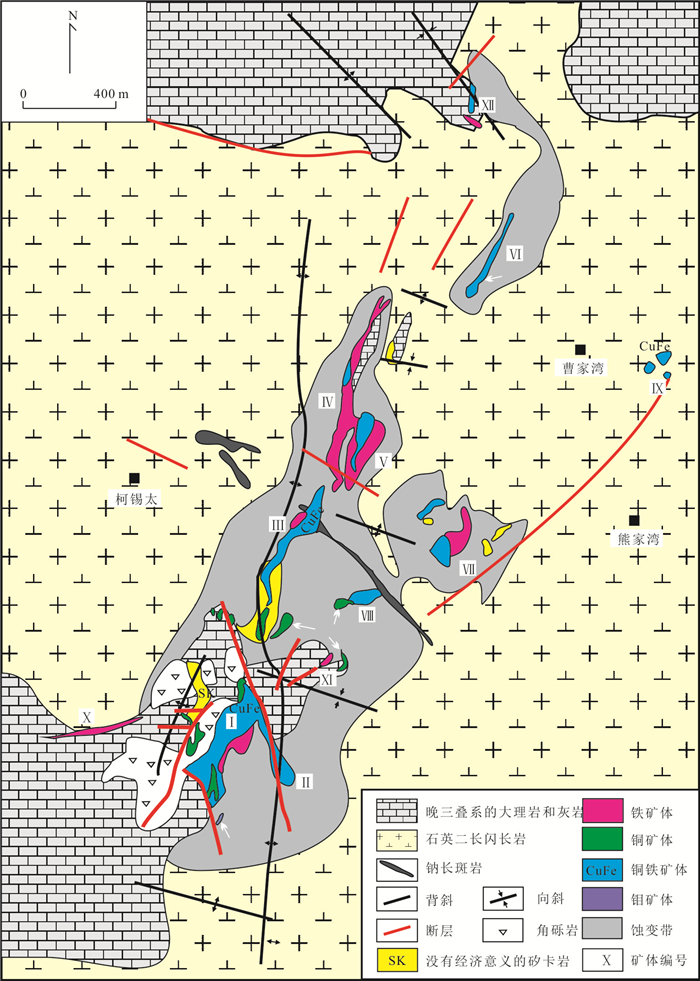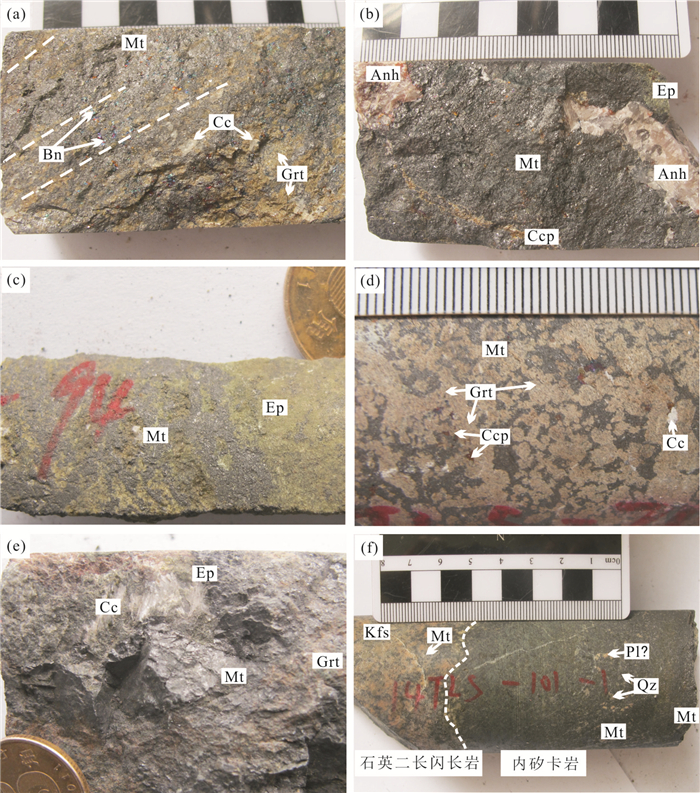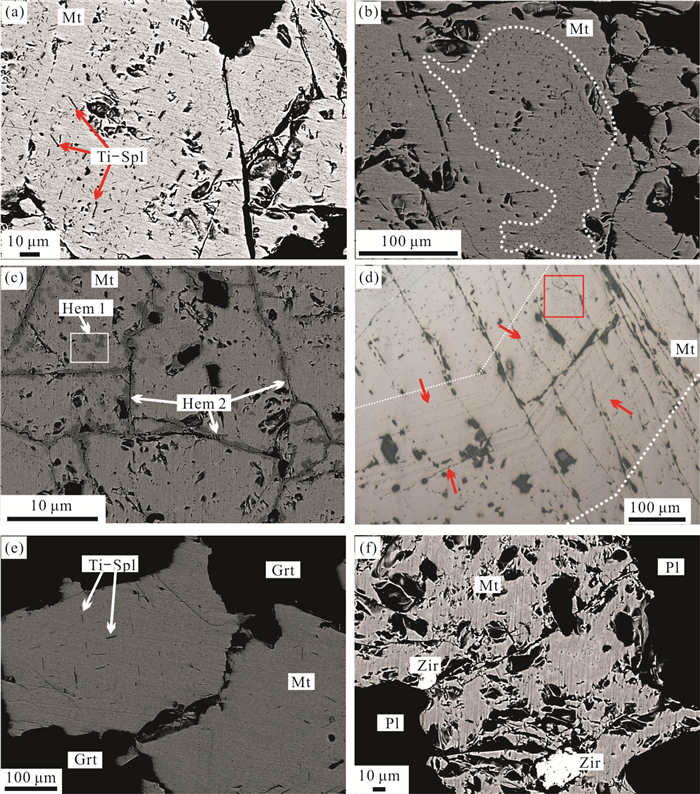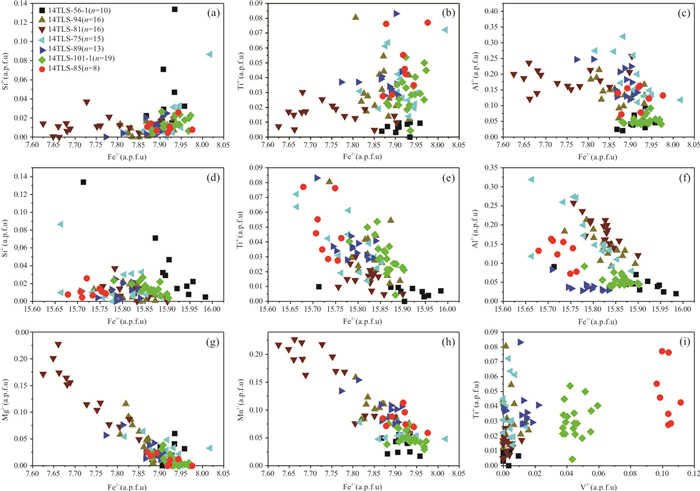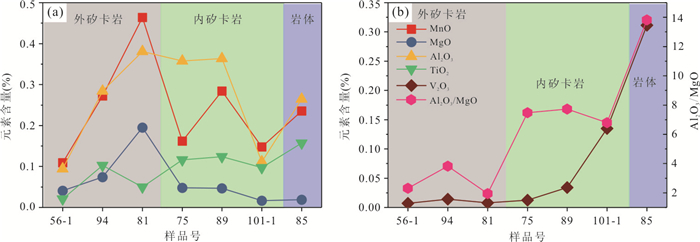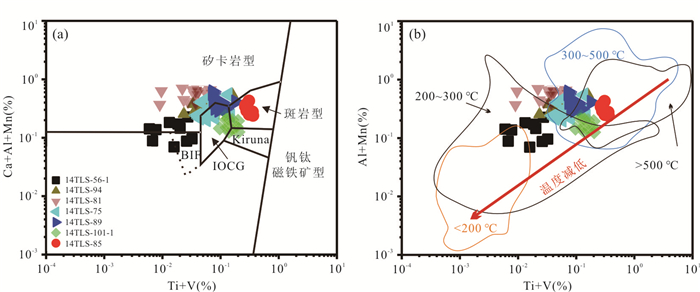Micro-Textures and Chemistry of Magnetite from the Tonglushan Skarn Cu-Fe Deposit and Its Implications for Ore-Forming Processes
-
摘要: 铜绿山矽卡岩型铜铁多金属矿床是长江中下游鄂东南矿集区的一个典型矿床,矿体产于铜绿山岩体与三叠系碳酸盐岩地层的接触带.磁铁矿是铜绿山铜铁矿床中广泛发育的矿石矿物,选取内矽卡岩和外矽卡岩中的热液磁铁矿以及岩体中副矿物磁铁矿为研究对象,对其开展系统的显微结构观察和电子探针分析.热液磁铁矿中普遍发育有钛尖晶石出溶结构和富硅环带结构,且没有明显的后期热液交代改造现象.钛尖晶石出溶结构指示铜绿山矿床的早期热液磁铁矿具有较高的Ti含量,磁铁矿结晶后经历了降温和氧逸度降低过程导致钛尖晶石出溶.热液磁铁矿中还普遍含有较高含量的Si、Al、Cr、V、Mn、Mg、Co和Ni等元素,Si4+、Al3+、Mg2+、Mn2+等以类质同象方式进入磁铁矿晶格;但在不同产状的磁铁矿中,替代强度和机制略有不同,说明流体成分、温度、压力等物理化学条件影响元素替代强度和方式.外矽卡岩中磁铁矿的Al2O3/MgO比值小于4,内矽卡岩中磁铁矿的Al2O3/MgO比值为5~8,而副矿物磁铁矿的Al2O3/MgO比值约为13.岩体副矿物磁铁矿具有最高的V2O3含量(平均值为0.31%),与岩体接触的内矽卡岩中的磁铁矿次之(平均值为0.14%),外矽卡岩中磁铁矿的V2O3含量最低(平均值为0.01%~0.03%).Al2O3/MgO比值和V2O3含量说明磁铁矿生长环境(熔体/热液)、围岩的成分及水-岩反应等对磁铁矿的化学组成均有影响.铜绿山矿床从岩体到内矽卡岩、再到外矽卡岩,磁铁矿的形成温度逐步下降,其成分的变化指示了磁铁矿可以作为矽卡岩矿床成矿过程的重要指示矿物.Abstract: The Tonglushan skarn Cu-Fe polymetallic deposit is located in the Edongnan metallogenic province along the Middle and Lower Yangtze River belt. Orebodies are hosted in the contact zone between the Tonglushan pluton and the Triassic carbonate rocks. Magnetite is widespread in the deposit and is one of the ore minerals. In this study, representative hydrothermal magnetite samples were collected from the exoskarn and endoskarn, as well as the igneous magnetite from the host intrusion, for detailed analyses of microtextures and elemental compositions. The hydrothermal magnetite grains commonly have Ti-spinel exsolutions textures and Si-rich bandings, and were weakly metasomatized by late stage hydrothermal fluids. The presence of Ti-spinel exsolutions textures indicates that the ore-forming fluids of the Tonglushan deposit may have high contents of Ti initially. The hydrothermal magnetite also has relatively high contents of Si, Al, Cr, V, Mn, Mg, Co and Ni. Si4+, Al3+, Mg2+, Mn2+ were incorporated into magnetite by a mechanism of isomorphism. However, the mechanism and intensity of isomorphism in different types of magnetite are various, indicating that element substitution was affected by fluids compositions, pressure and temperature physicochemical conditions. Al2O3/MgO ratios are less than 4 in magnetite from exoskarn, vary from 5-8 in magnetite from endoskarn, and are around 13 for igneous magnetite. Igneous magnetite within intrusion has highest V2O3(on average 0.31%), magnetite within endoskarn has intermediate values(on average 0.14%), and magnetite from exoskarn has lowest V2O3 values(on average 0.01%-0.03%). The Al2O3/MgO ratios and V2O3 contents clearly demonstrate that growth of magnetite was affected by composition of melts/fluids, composition of country rocks, and fluid-rock interactions. The trend of decreased temperature for magnetite from the hosting intrusion, endoskarn, and exoskarn, and the trend of elemental compositions in Tonglushan deposit show that magnetite is a good indicator mineral for skarn deposit.
-
Key words:
- skarn deposit /
- magnetite /
- microtexture /
- elemental composition /
- ore-forming processes /
- ore deposit
-
图 1 鄂东南矿集区地质简图
据舒全安等(1992)修改;1.第四系;2.上白垩统到第三系;3.中二叠统到中侏罗统;4.下泥盆统到上三叠统;5.震旦系到志留系;7.闪长岩类的岩石;8.石英闪长岩类的岩石;9.早白垩世的火山岩;10.玄武岩;11.背斜;12.倒转背斜;13.向斜;14.倒转向斜;15.断陷盆地;16.断裂;17.走滑断层;18.铁矿床;19.铜矿床;20.铁铜钼多金属矿床;21.城镇
Fig. 1. Simplified geological map of ore-centralization area, southeastern Hubei Province
图 4 铜绿山矿床磁铁矿的手标本特征
a.外矽卡岩中条带状的磁铁矿(14TLS-56-1),较好地保留了围岩的层理结构;b.外矽卡岩中块状的磁铁矿(14TLS-81),被硬石膏穿插;c.外矽卡岩中透辉石、绿帘石和浸染状磁铁矿共生(14TLS-94);d.内矽卡岩中浸染状的磁铁矿(14TLS-75);e.内矽卡岩中脉状的磁铁矿(14TLS-89);f.与岩体直接接触的内矽卡岩中的磁铁矿(14TLS-101-1).Anh.硬石膏;Cc.方解石;Ccp.黄铜矿;Bn.斑铜矿;Di.透辉石;Ep.绿帘石;Grt.石榴子石;Mt.磁铁矿
Fig. 4. Field photos of the magnetite in hand specimens from the Tonglushan deposit
图 5 铜绿山矿床不同产状磁铁矿的显微结构特征
a.外矽卡岩(14TLS-81)中块状磁铁矿中出溶的钛尖晶石(BSE);b.外矽卡岩中浸染状的磁铁矿(14TLS-94),在磁铁矿颗粒的中心部位在BSE图像中显示为黑色孔隙发育,其主要为硅酸盐矿物包裹体,而磁铁矿边部多为光滑,矿物包裹体含量少(BSE);c.内矽卡岩中浸染状磁铁矿(14TLS-75),赤铁矿主要沿着磁铁矿的裂隙或者颗粒边缘分布(Hem2)或呈乳浊状的形式(Hem1)不规则交代(BSE);d.内矽卡岩中的脉状磁铁矿中(14TLS-89)发育富硅的生长环带结构(箭头所示),边部含有一些硅酸盐矿物包裹体(方框内部)(反射光);e.与岩体直接接触的内矽卡岩(14TLS-101-1)的磁铁矿内发育钛尖晶石出溶物(BSE);f.岩体中的副矿物磁铁矿(14TLS-85),磁铁矿与斜长石接触,含有锆石矿物包裹体.Pl.斜长石;Grt.石榴子石;Hem.赤铁矿;Mt.磁铁矿;Ti-Spl.钛尖晶石;Zir.锆石
Fig. 5. Photomicrographs and BSE images showing different types of magnetite in the Tonglushan deposit
图 8 铜绿山磁铁矿Ca+Al+Mn vs. Ti+V判别图解(a)和形成温度条件(b)
据Dupuis and Beaudoin(2011)、Nadoll et al.(2012, 2014);b.中红色箭头代表着磁铁矿结晶温度降低的趋势,温度范围是根据统计不同形成温度的磁铁矿而限定,据Nadoll et al.(2014).BIF.条带状铁建造;IOCG.铁氧化物铜金矿床;Kiruna.基鲁纳型
Fig. 8. The Ca+Al+Mn vs. Ti+V discriminant diagram (a) and formation temperatures diagram (b) for average compositions of magnetite in Tonglushan deposit
-
Dare, S. A. S., Barnes, S. J., Beaudoin, G., 2012. Variation in Trace Element Content of Magnetite Crystallized from a Fractionating Sulfide Liquid, Sudbury, Canada:Implications for Provenance Discrimination. Geochimica et Cosmochimica Acta, 88:27-50. https://doi.org/10.1016/j.gca.2012.04.032 Dare, S. A. S., Barnes, S. J., Beaudoin, G., et al., 2014. Trace Elements in Magnetite as Petrogenetic Indicators. Mineralium Deposita, 49(7):785-796. https://doi.org/10.1007/s00126-014-0529-0 Dare, S. A. S., Barnes, S. J., Beaudoin, G., 2015. Did the Massive Magnetite "Lava Flows" of El Laco (Chile) Form by Magmatic or Hydrothermal Processes? New Constraints from Magnetite Composition by LA-ICP-MS. Mineralium Deposita, 50(5):607-617. https://doi.org/10.1007/s00126-014-0560-1 Droop, G. T. R., 1987. A General Equation for Estimating Fe3+ Concentrations in Ferromagnesian Silicates and Oxides from Microprobe Analyses, Using Stoichiometric Criteria. Mineralogical Magazine, 51(361):431-435. https://doi.org/10.1180/minmag.1987.051.361.10 Dupuis, C., Beaudoin, G., 2011. Discriminant Diagrams for Iron Oxide Trace Element Fingerprinting of Mineral Deposit Types. Mineralium Deposita, 46(4):319-335. https://doi.org/10.1007/s00126-011-0334-y Groves, D. I., Bierlein, F. P., Meinert, L. D., et al., 2010. Iron Oxide Copper-Gold (IOCG) Deposits through Earth History:Implications for Origin, Lithospheric Setting, and Distinction from other Epigenetic Iron Oxide Deposits. Economic Geology, 105(3):641-654. https://doi.org/10.2113/gsecongeo.105.3.641 Hu, H., Duan, Z., Luo, Y., et al., 2014. Trace Element Systematics of Magnetite from the Chengchao Iron Deposit in the Daye District:A Laser Ablation ICP-MS Study and Insights into Ore Genesis. Acta Petrologica Sinica, 30(5):1292-1306 (in Chinese with English abstract). http://d.old.wanfangdata.com.cn/Periodical/ysxb98201405008 Hu, H., Lentz, D., Li, J., et al., 2015. Reequilibration Processes in Magnetite from Iron Skarn Deposits. Economic Geology, 110(1):1-8. https://doi.org/10.2113/econgeo.110.1.1 Hu, H., Li, J. W., Lentz, D., et al., 2014. Dissolution-Reprecipitation Process of Magnetite from the Chengchao Iron Deposit:Insights into Ore Genesis and Implication for In-Situ Chemical Analysis of Magnetite. Ore Geology Reviews, 57:393-405. https://doi.org/10.1016/j.oregeorev.2013.07.008 Huang, X. W., Gao, J. F., Qi, L., et al., 2015b. In-Situ LA-ICP-MS Trace Elemental Analyses of Magnetite and Re-Os Dating of Pyrite:The Tianhu Hydrothermally Remobilized Sedimentary Fe Deposit, NW China. Ore Geology Reviews, 65:900-916. https://doi.org/10.1016/j.oregeorev.2014.07.020 Huang, X. W., Zhou, M. F., Qiu, Y. Z., et al., 2015a. In-Situ LA-ICP-MS Trace Elemental Analyses of Magnetite:The Bayan Obo Fe-REE-Nb Deposit, North China. Ore Geology Reviews, 65:884-899. https://doi.org/10.1016/j.oregeorev.2014.09.010 Huberty, J. M., Konishi, H., Heck, P. R., et al., 2012. Silician Magnetite from the Dales Gorge Member of the Brockman Iron Formation, Hamersley Group, Western Australia. American Mineralogist, 97(1):26-37. https://doi.org/10.2138/am.2012.3864 La Tourrette, T. Z., Burnett, D. S., Bacon, C. R., 1991. Uranium and Minor-Element Partitioning in Fe-Ti Oxides and Zircon from Partially Melted Granodiorite, Crater Lake, Oregon. Geochimica et Cosmochimica Acta, 55(2):457-469. https://doi.org/10.1016/0016-7037(91)90004-o Li, J. W., Vasconcelos, P. M., Zhou, M. F., et al., 2014. Longevity of Magmatic-Hydrothermal Systems in the Daye Cu-Fe-Au District, Eastern China with Implications for Mineral Exploration. Ore Geology Reviews, 57:375-392. https://doi.org/10.1016/j.oregeorev.2013.08.002 Lin, S. Z., 1982. A Contribution to the Chemistry, Origin and Evolution of Magnetite. Acta Mineralogica Sinica, 2(3):166-174 (in Chinese with English abstract). Liu, P. P., Zhou, M. F., Chen, W. T., et al., 2015. In-Situ LA-ICP-MS Trace Elemental Analyses of Magnetite:Fe-Ti-(V) Oxide-Bearing Mafic-Ultramafic Layered Intrusions of the Emeishan Large Igneous Province, SW China. Ore Geology Reviews, 65:853-871. https://doi.org/10.1016/j.oregeorev.2014.09.002 Nadoll, P., Angerer, T., Mauk, J. L., et al., 2014. The Chemistry of Hydrothermal Magnetite:A Review. Ore Geology Reviews, 61:1-32. https://doi.org/10.1016/j.oregeorev.2013.12.013 Nadoll, P., Mauk, J. L., Hayes, T. S., et al., 2012. Geochemistry of Magnetite from Hydrothermal Ore Deposits and Host Rocks of the Mesoproterozoic Belt Supergroup, United States. Economic Geology, 107(6):1275-1292. https://doi.org/10.2113/econgeo.107.6.1275 Nielsen, R. L., Forsythe, L. M., Gallahan, W. E., et al., 1994. Major- and Trace-Element Magnetite-Melt Equilibria. Chemical Geology, 117(1-4):167-191. https://doi.org/10.1016/0009-2541(94)90127-9 Ray, G. E., Webster, I. C. L., 2007. Geology and Chemistry of the Low Ti Magnetite-Bearing Heff Cu-Au Skarn and Its Associated Plutonic Rocks, Heffley Lake, South-Central British Columbia. Exploration and Mining Geology, 16(3/4):159-186. https://doi.org/10.2113/gsemg.16.3-4.159 Ryzhenko, B. N., Kovalenko, N. I., Prisyagina, N. I., 2006. Titanium Complexation in Hydrothermal Systems. Geochemistry International, 44(9):879-895. https://doi.org/10.1134/s0016702906090047 Shiga, Y., 1989. Further Study on Silician Magnetite. Mining Geology, 39:305-309. https://doi.org/10.11456/shigenchishitsu1951.39.217_305 Shimazaki, H., 1998. On the Occurrence of Silician Magnetites. Resource Geology, 48(1):23-29. https://doi.org/10.1111/j.1751-3928.1998.tb00004.x Shu, Q. A., Chen, P. L., Cheng, J. R., 1992. The Geology of Iron and Copper Deposits in Eastern Hubei Province. Metallurgical Industry Press, Beijing (in Chinese). Toplis, M. J., Corgne, A., 2002. An Experimental Study of Element Partitioning between Magnetite, Clinopyroxene and Iron-Bearing Silicate Liquids with Particular Emphasis on Vanadium. Contributions to Mineralogy and Petrology, 144(1):22-37. https://doi.org/10.1007/s00410-002-0382-5 Van Baalen, M. R., 1993. Titanium Mobility in Metamorphic Systems:A Review. Chemical Geology, 110(1-3):233-249. https://doi.org/10.1016/0009-2541(93)90256-i Wang, P., 2008. Ore Petrology. China University of Geosciences Press, Wuhan (in Chinese). Westendorp, R. W., Watkinson, D. H., Jonasson, I. R., 1991. Silicon-Bearing Zoned Magnetite Crystals and the Evolution of Hydrothermal Fluids at the Ansil Cu-Zn Mine, Rouyn-Noranda, Quebec. Economic Geology, 86(5):1110-1114. https://doi.org/10.2113/gsecongeo.86.5.1110 Williams, P. J., Barton, M. D., Johnson, D. A., et al., 2005. Iron Oxide Copper-Gold Deposits: Geology, Space-Time Distribution, and Possible Modes of Origin. In: Hedenquist, J. W., Thompson, J. F. H., Goldfarb, R. J., eds., Economic Geology, 100th Aniversary Volume, SEG, Denver, 371-405. Xu, G. F., Shao, J.L., 1979. Standard Characteristics of Magnetite and Its Practical Significance. Geology and Prospecting, 3:30-37 (in Chinese). Yu, Y. C., Xiao, G. Q., Li, G., 1985. Contact Metasomatic-Type Tonglvshan Iron-Copper Deposit in Daye County, Hubei Province. Geological Team of Southeast Hubei Province, Daye (in Chinese). Zhai, Y. S., Yao, S. Z., Cai, K. Q., 2011. Mineral Deposit (Third Edition). Geological Publishing House, Beijing (in Chinese). Zhao, H. J., Mao, J. W., Xie, G. Q., et al., 2010. Ore-Forming Fluids of the Tonglushan Copper-Gold Skarn Deposit, Hubei Province. Mineral Deposits, 29(S1):628-672 (in Chinese). Zhao, H. J., Xie, G. Q., Wei, K. T., et al., 2012. Mineral Compositions and Fluid Evolution of the Tonglushan Skarn Cu-Fe Deposit, SE Hubei, East-Central China. International Geology Review, 54(7):737-764. https://doi.org/10.1080/00206814.2011.569418 Zhao, S. R., Bian, Q. J., Lin, Q. C., 2004. Crystallography and Mineralogy. Higher Education Press, Beijing (in Chinese). Zhao, W. W., Zhou, M. F., 2015. In-Situ LA-ICP-MS Trace Elemental Analyses of Magnetite:The Mesozoic Tengtie Skarn Fe Deposit in the Nanling Range, South China. Ore Geology Reviews, 65:872-883. https://doi.org/10.1016/j.oregeorev.2014.09.019 胡浩, 段壮, Luo, Y., 等, 2014.鄂东程潮铁矿床磁铁矿的微量元素组成及其矿床成因意义.岩石学报, 30(5):1292-1306. http://d.old.wanfangdata.com.cn/Periodical/ysxb98201405008 林师整, 1982.磁铁矿矿物化学、成因及演化的探讨.矿物学报, 2(3):166-174. doi: 10.3321/j.issn:1000-4734.1982.03.002 舒全安, 陈培良, 程建荣, 1992.鄂东铁铜矿产地质.北京:冶金工业出版社. 王苹, 2008.矿石学教程.武汉:中国地质大学出版社. 徐国风, 邵洁涟, 1979.磁铁矿的标型特征及其实际意义.地质与勘探, 3:30-37. 余元昌, 肖国荃, 李刚, 1985.湖北省大冶县铜绿山接触交代铜铁矿床.大冶: 湖北省鄂东南地质大队. 翟裕生, 姚书振, 蔡克勤, 2011.矿床学(第三版).北京:地质出版社. 赵海杰, 毛景文, 谢桂青, 等, 2010.湖北铜绿山铜铁矿床成矿流体研究.矿床地质, 29(S1):628-672. http://d.old.wanfangdata.com.cn/Conference/7413216 赵珊茸, 边秋娟, 凌其聪, 2004.结晶学及矿物学.北京:高等教育出版社. -
 dqkx-45-1-118-Table1.pdf
dqkx-45-1-118-Table1.pdf

-









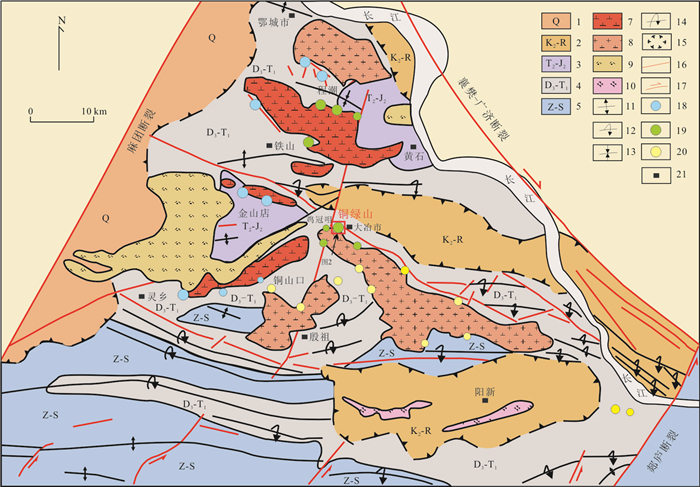
 下载:
下载:
